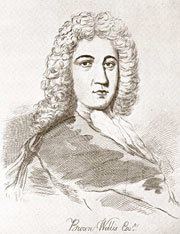Name Browne Willis Died February 5, 1760 | Role Author | |
 | ||
Education | ||
Browne Willis (16 September 1682 – 5 February 1760) was an antiquary, author, numismatist and politician who sat in the House of Commons from 1705 to 1708.
Contents
Early life
Willis was born at Blandford St Mary, Dorset, the eldest Son of Thomas Willis of Bletchley, Buckinghamshire and his wife Alice Browne, daughter of Robert Browne of Frampton, Dorset. He was grandson of Dr Thomas Willis, the physician. He was educated at Bechampton School in the care of Abraham Freestone and at Westminster School. He attended Christ Church, Oxford and entered the Inner Temple in 1700.
He joined the recently reformed Society of Antiquaries in 1717-18.
Political career
In 1705, Willis was elected Member of Parliament for Buckingham. He held the seat until 1708.
Published works
His published works are:
St Martin's Church and the Fenny Poppers
Between 1724 and 1730, Browne Willis built St. Martin's Church on the site of the old Chantry Chapel of St. Margaret and St. Catherine at Fenny Stratford. He erected the church as a memorial to his grandfather Dr. Thomas Willis, a famous physician who lived in St. Martin's Lane in the parish of St. Martin-in-the-Fields in London and died on St. Martin's Day, 11 November 1675.
In order to perpetuate his own memory Browne Willis arranged for a sermon to be preached at St. Martin's Church on each St. Martin's Day, for which a fee was payable. During his lifetime, he also celebrated the occasion with a dinner attended by local clergy and gentry. The firing of the 'Fenny Poppers', six small cannon, dates from this time, but there is no record of their first use. In 1740 Browne Willis bought a house in Aylesbury Street, Fenny Stratford and the rent from this was used to pay for the sermon and gunpowder for the Fenny Poppers. Following his death in 1760, the traditions were carried on and later documented.
All six poppers were re-cast by the Eagle Foundry, Northampton in 1859 after one of them burst. They are still in use today, and were recently examined and x-rayed to ensure there are no cracks.
During their long history, many sites have been used for this battery. These include; the Canal Wharf, land behind the Church, St, Martin's Hall, the Churchyard and now the Leon Recreation Ground, which was once part of the lands belonging to the Chantry.
The poppers each weigh about 19 pounds (8.5 kg). The bore, 6 " by 1.75" (150 by 44 mm) will take up to 1oz. (28g) of gunpowder, which is plugged with well-rammed newspaper. They are fired three times on St. Martin's Day: noon, 2pm and 4pm. There is of course no connection with Remembrance Day (also 11 November).
In 1901 they were fired to mark the death of Queen Victoria. The 81 salvoes were heard as far away as Olney.
On 1 January 2000 at 11am the poppers were fired to mark the beginning of the second millennium.
On 4 August 2000 at 2pm a salute of six poppers was fired to celebrate the 100th birthday of Queen Elizabeth, the Queen Mother.
On 5 June 2012 at 2pm a salute was fired to mark the Diamond Jubilee of Queen Elizabeth II.
